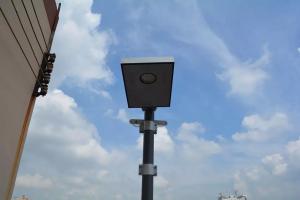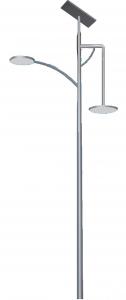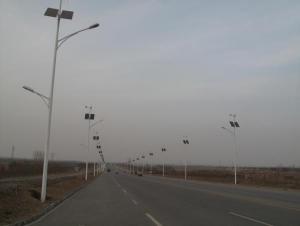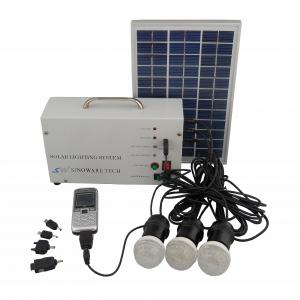Solar Light Bug Zapper:Off Grid New Energy Solar Product 088HU
- Loading Port:
- Shanghai
- Payment Terms:
- TT OR LC
- Min Order Qty:
- 1 watt
- Supply Capability:
- 5000 watt/month
OKorder Service Pledge
OKorder Financial Service
You Might Also Like
1, Product desciption
Inverter circuits designed to produce a variable output voltage range are often used within motor speed controllers.
The DC power for the inverter section can be derived from a normal AC wall outlet or some other source. Control and feedback circuitry is used to adjust the final output of the inverter section which will ultimately determine the speed of the motor operating under its mechanical load.
Motor speed control needs are numerous and include things like: industrial motor driven equipment, electric vehicles, rail transport systems, and power tools. (See related: variable-frequency drive ) Switching states are developed for positive, negative and zero voltages as per the patterns given in the switching Table.
The generated gate pulses are given to each switch in accordance with the developed pattern and thus the output is obtained.
Solar power is energy from the sun. "Solar" is the Latin word for "sun" and
And Powerful source of energy. Without it, there will be no life.
Solar energy is considered as a serious source of energy for many years
of the vast amounts of energy that is made freely available, if harnessed by modern technology.
A magnifying glass can be used to heat up a small amount of water.
The short piece of copper tube is sealed at one end and filled with water.
And magnifying glass is then used to warm up the pipe.
Using more than one magnifying glass will increase the temperature more rapidly.
2, Features of the product
Inverters convert low frequency main AC power to higher frequency for use in induction heating.
To do this, AC power is first rectified to provide DC power. The inverter then changes the DC power to high frequency AC power. Due to the reduction in the number of DC Sources employed, the structure becomes more reliable and the output voltage has higher resolution due to an increase in the number of steps so that the reference sinusoidal voltage can be better achieved.
High reliability with guaranteed +/-10% output power tolerance
Proven materials,tempered front glass,and a sturdy anodized aluminum frame allow modules to operate reliably in multiple mountily configurations
Combination of high efficicncy and attractive appearance
The first thing to figure out is the length of road in need of street lights.
This can be a small entrance road only a couple hundred of feet long to miles of streets through an area. Does the area currently have any type of lighting available.
What is the reason for needing street lights in this area
Is the electrical grid already nearby or would you need to call in the power company to bring in electrical lines.
3, Detailed Specification
Data Sheet of High Quality Solar Controller Tracer-1210RN
ModelTracer-1210RN
Rated system voltage12/24V auto work
Rated battery current10A
Rated load current10A
Max.battery voltage32V
Max.PV open circuit voltage100VDC
Max.PV input power12V 130W;24V 260W
Self-consumption<10ma(24v)< span="">
Charge Circuit Voltage<=0.26v< span="">
Discharge Circuit Voltage Drop<=0.15v< span="">
CommunicationTTL232/8 pin RJ45
Temp/compensation-30mV/℃/12V(25℃)
Working temperature-35℃~+55℃
Storage temperature range-35℃~+55℃
4, Product Image

- Q: Are there solar lights with GPS tracking capabilities?
- Yes, there are solar lights available in the market with GPS tracking capabilities. These lights are designed to harness solar energy during the day and use it to power their built-in GPS tracking system. This feature allows users to track the location of the lights in real-time, making them ideal for various applications. For instance, in outdoor security lighting, solar lights with GPS tracking can help monitor and track the movement of potential intruders. Additionally, in remote areas or during emergencies, these lights can be used to provide illumination while also allowing users to locate them easily. Overall, solar lights with GPS tracking capabilities offer enhanced functionality and convenience in various scenarios.
- Q: Can solar lights be used as street lights?
- Solar lights have the potential to function as street lights. As a matter of fact, solar street lights are gaining popularity due to the numerous advantages they offer compared to traditional street lights. These street lights are powered by solar panels that convert sunlight into electricity, eliminating the necessity for grid connection or electrical wiring. This characteristic makes them more cost-effective and environmentally friendly. Furthermore, solar street lights are not reliant on the power grid, allowing for installation in remote areas or locations with unreliable electricity supply. They also possess integrated sensors that automatically activate the lights at dusk and deactivate them at dawn, conserving energy and ensuring consistent illumination. Solar street lights possess a lengthy lifespan and require minimal upkeep, rendering them an environmentally sustainable and efficient lighting solution for streets and public areas.
- Q: What is the charging time for solar lights?
- The charging time for solar lights can vary depending on factors such as the size of the solar panel and the amount of sunlight available. However, on average, it usually takes around 6 to 8 hours of direct sunlight to fully charge solar lights.
- Q: Are there solar lights with built-in timers or dimming capabilities?
- Yes, there are solar lights available in the market with built-in timers and dimming capabilities. These lights offer the convenience of automatically turning on and off at specific times, and also allow users to adjust the brightness levels according to their preference.
- Q: How do you dispose of solar light batteries?
- Solar light batteries should not be disposed of in regular household waste. It is recommended to take them to a recycling center or a designated battery recycling facility. These centers are equipped to handle and properly dispose of batteries, ensuring that any potentially harmful materials are safely handled and recycled.
- Q: Do solar lights have a built-in timer?
- Yes, some solar lights do have a built-in timer. The timer allows the lights to automatically turn on and off at specific times, conserving energy and ensuring they are only illuminated when needed.
- Q: How do solar lights perform in extreme temperatures?
- Solar lights perform well in extreme temperatures as long as they are designed to withstand the specific temperature range. High-quality solar lights are built with durable materials that can resist both very hot and very cold temperatures, ensuring their longevity and optimal performance in various weather conditions. However, it is important to check the specifications of each solar light model to determine its temperature range tolerance.
- Q: Do solar lights require a separate power source or battery?
- Solar lights are self-sufficient, as they derive energy from the sun and do not rely on a separate power source or battery. Their design includes a solar panel that captures sunlight and converts it into electricity, which is then stored in an integrated battery. This stored energy is utilized to illuminate the light when it is dark or when sunlight is not available. Throughout the day, the solar panel continuously replenishes the battery, enabling the light to operate autonomously without any additional power sources or batteries.
- Q: Can solar lights be charged using a USB port?
- No, solar lights cannot be charged using a USB port. They rely on sunlight to generate electricity and store it in their built-in batteries.
- Q: Are there solar lights with built-in Wi-Fi connectivity?
- Solar lights with built-in Wi-Fi connectivity are available in the market. These lights serve the dual purpose of providing lighting and wireless connectivity, making them suitable for various applications. By connecting to your home network, these lights can be controlled and monitored remotely through a smartphone app or web portal. This connectivity feature allows you to adjust brightness, set timers, and receive notifications about the status of your solar lights. Some models even come with additional features like motion sensors, security cameras, or integration with smart home systems. In conclusion, these solar lights with built-in Wi-Fi offer a convenient and energy-efficient lighting solution, along with the added benefits of wireless connectivity.
Send your message to us
Solar Light Bug Zapper:Off Grid New Energy Solar Product 088HU
- Loading Port:
- Shanghai
- Payment Terms:
- TT OR LC
- Min Order Qty:
- 1 watt
- Supply Capability:
- 5000 watt/month
OKorder Service Pledge
OKorder Financial Service
Similar products
Hot products
Hot Searches
Related keywords




























